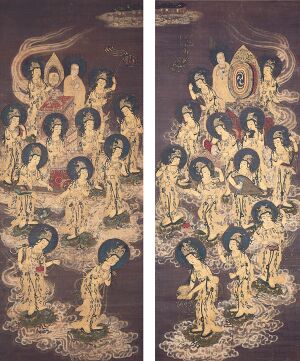Bodisatva
Bodisatva es un término sánscrito que literalmente significa ser de bodi (o iluminación), un ser destinado a la iluminación, o cuya energía y poder están dirigidos a la iluminación. Un bodisatva es alguien que está destinado a convertirse en un Buda, pero que ha renunciado a la bendición del nirvana por su compromiso de salvar a todos los hijos de Dios en la Tierra.

En la escuela de budismo Mahayana, convertirse en un bodisatva es la meta del Sendero. El sendero del bodisatva se divide generalmente en diez etapas, llamadas bumis. El bodisatva se esfuerza para progresar de una etapa a la siguiente hasta que obtiene la iluminación.
The meaning of the word
Summarizing the bodhisattva ideal in Buddhism, Professors David Lopez and Steven Rockefeller write:
The Sanskrit term bodhisattva is composed of two words, bodhi and sattva. Bodhi is derived from the verbal root budh, meaning 'wake' so that bodhi is the state of being awake.
In the context of the Buddhist path, bodhi is the state of having awakened from the sleep of ignorance; it is enlightenment.
The second component of the term, sattva, can mean “sentient being,” in which case the compound bodhisattva would be read as “a being [seeking] enlightenment.”...
A second meaning of sattva is “mind” or “intention,” so that a Bodhisattva would be “one whose mind or intention is directed toward enlightenment.”...
Bodhisattvas are unwilling to be satisfied merely by securing their own liberation and, deeply moved by the sight of the sufferings of other sentient beings, feel compassion for them and determine to become Buddhas so as to be able to provide the maximum benefit to others.
The Bodhisattva thus vows to become a Buddha in order to free all beings in the universe from suffering regardless of how many beings there are or how many aeons this might require....
Thus, the Bodhisattva is said to have two aims: the welfare of all sentient beings and the achievement of Buddhahood.
A Bodhisattva will be endowed with inconceivable wisdom, compassion and power and knowledge of limitless methods for freeing beings from suffering.[1]
Geshe Wangyal defines bodhisattva as
“Offspring of the Conqueror.” One who has vowed to attain enlightenment for the sake of all living beings. The term bodhisattva refers to those at many levels: from those who have generated aspiration to enlightenment for the first time, through to those who have actually entered the Bodhisattva path, which is developed through the ten stages and culminates in enlightenment, the attainment of Buddhahood.[2]
The bodhisattva ideal
The Buddhist philosopher and sage Nagarjuna, in his book written around the second century, defined what a Bodhisattva is:
The essential nature of all Bodhisattvas is a great loving heart, and all sentient beings constitute the object of its love. Therefore, all the Bodhisattvas do not cling to the blissful taste that is produced by the diverse modes of mental tranquilisation, do not covet the fruit of their meritorious deeds, which may heighten their own happiness....
With a great loving heart they look upon the sufferings of all beings, who are diversely tortured in Avici Hell in consequence of their sins—a hell whose limits are infinite and where an endless round of misery is made possible on account of all sorts of karma [committed by sentient creatures]. The Bodhisattvas filled with pity and love desire to suffer themselves for the sake of those miserable beings.
But they are well acquainted with the truth that all those diverse sufferings causing diverse states of misery are in one sense apparitional and unreal, while in another sense they are not so....
Therefore, all Bodhisattvas, in order to emancipate sentient beings from misery, are inspired with great spiritual energy and mingle themselves in the filth of birth and death. Though thus they make themselves subject to the laws of birth and death, their hearts are free from sins and attachments. They are like unto those immaculate, undefiled lotus-flowers which grow out of mire, yet are not contaminated by it.
Their great hearts of sympathy which constitute the essence of their being never leave suffering creatures behind [in their journey towards enlightenment].[3]
Scholar Har Dayal writes:
The bodhisattva ideal reminds us of the active altruism of the Franciscan friars in the thirteenth century A.D. as contrasted with the secluded and contemplative religious life of the Christian monks of that period. The monk prayed in solitude: the friar “went about doing good.”...
Both the arhat [a Buddhist adept or saint] and the bodhisattva were unworldly idealists; but the arhat exhibited his idealism by devoting himself to meditation and self-culture, while the bodhisattva actively rendered service to other living beings.[4]
Bodhisattvas
Para más información
Elizabeth Clare Prophet, Maitreya on Initiation
Notas
Mark L. Prophet y Elizabeth Clare Prophet, Saint Germain Sobre Alquimia: Fórmulas para la autotransformation.
Elizabeth Clare Prophet, Maitreya on Initiation.
Elizabeth Clare Prophet, “The Age of Maitreya,” October 28, 1990.
- ↑ The Christ and The Bodhisattva, Donald S. Lopez, Jr. and Steven C. Rockefeller, eds., (New York: State University of New York Press, 1987), pp. 24, 25.
- ↑ Geshe Wangyal, trans., The Door of Liberation (New York: Lotsawa, 1978), p. 208.
- ↑ Daisetz Teitaro Suzuki, Outlines of Mahayana Buddhism (1907; reprint, New York: Schocken Books, 1963), pp. 292–94.
- ↑ Har Dayal, The Bodhisattva Doctrine in Buddhist Sanskrit Literature (New York: Samuel Weiser, Inc., 1932), p. 29.
